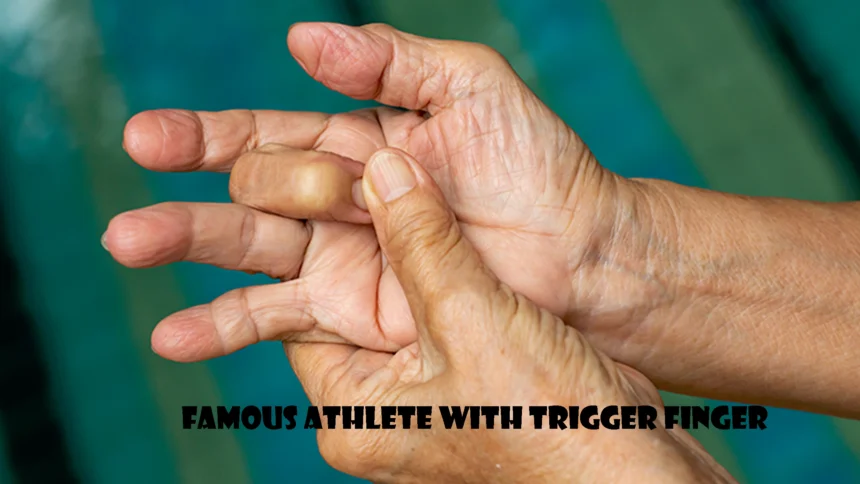Trigger finger is a condition that affects many athletes who rely on their hands for gripping, throwing, or swinging. It occurs when a tendon in the finger becomes inflamed, causing the finger to get stuck in a bent position. Athletes in sports like golf, baseball, tennis, and boxing are at higher risk due to repetitive hand movements. While the condition can be painful and limit performance, many athletes have successfully managed it through treatment and therapy.
Famous athletes with trigger finger often experience stiffness, pain, and difficulty in finger movement. This condition can worsen if left untreated, affecting their ability to hold equipment or perform essential movements.
The risk increases with overuse and underlying health conditions such as diabetes or arthritis. Some of the most famous athletes with trigger finger have dealt with this issue and found ways to continue performing at the highest level.
Understanding trigger finger and its effects on athletes can help in early diagnosis and effective management. There are various treatment methods, ranging from physical therapy to surgery, depending on the severity of the condition. Preventive measures such as proper warm-ups, finger exercises, and the use of supportive gear can also reduce the risk of developing trigger finger.
What is Trigger Finger and How Does it Develop in Athletes?
Trigger finger, also known as stenosing tenosynovitis, is a condition where the tendons controlling finger movement become inflamed. The inflammation causes the tendon sheath to narrow, making it difficult for the tendon to glide smoothly. This results in a snapping or locking sensation when trying to move the finger. Over time, the affected finger may become stuck in a bent position, requiring manual straightening.
Athletes are more likely to develop trigger finger due to the repetitive use of their hands. Those who constantly grip sports equipment, such as tennis rackets, golf clubs, or baseball bats, put excessive strain on their finger tendons. The condition may also develop after an injury, where swelling leads to restricted movement. Without proper rest and treatment, the condition can progress, causing chronic pain and limiting performance.
The symptoms of trigger finger include pain at the base of the affected finger, stiffness, and a clicking sensation when moving the finger. In severe cases, the finger may become completely locked in a bent position. Early diagnosis is crucial for effective treatment, as untreated trigger finger can lead to permanent tendon damage. Athletes who notice any discomfort or stiffness in their fingers should seek medical advice to prevent further complications.
Famous Athletes Who Have Experienced Trigger Finger
Several well-known athletes have struggled with trigger finger during their careers. These athletes relied on their hands for gripping and controlling sports equipment, making it a serious issue for their performance. Through proper treatment and rehabilitation, they were able to manage the condition and continue competing at high levels.
Phil Mickelson (Golf)
Phil Mickelson, a professional golfer, suffered from trigger finger due to years of gripping his golf club. The condition caused stiffness and pain, affecting his ability to hold and swing the club properly. He underwent therapy and made grip modifications to manage the condition, allowing him to continue competing.
Tyson Fury (Boxing)
Tyson Fury, a world-famous boxer, experienced inflammation in his finger tendons due to constant fist clenching and punching. The stiffness and pain in his fingers made it difficult to train effectively. He used therapy and finger exercises to improve flexibility and regain full movement.
Clayton Kershaw (Baseball)
As a Major League Baseball pitcher, Clayton Kershaw developed symptoms of trigger finger from repetitive pitching motions. The strain on his fingers led to tendon inflammation, affecting his grip on the baseball. He managed his condition through physical therapy and modified his hand movements to reduce stress on his fingers.
Tennis Players – Rafael Nadal & Roger Federer
Tennis players such as Rafael Nadal and Roger Federer have faced hand and finger injuries, including trigger finger. The continuous gripping of the tennis racket caused tendon strain, leading to stiffness and discomfort. Both players used preventive exercises and treatment techniques to maintain their performance.
Impact of Trigger Finger on an Athlete’s Performance
Trigger finger can significantly affect an athlete’s ability to perform, especially in sports that require strong grip control. The pain and stiffness associated with the condition make it challenging to hold or manipulate sports equipment effectively. If left untreated, trigger finger can lead to long-term damage and affect an athlete’s career.
One of the biggest issues caused by trigger finger is reduced grip strength. In sports like golf, tennis, and baseball, a strong grip is essential for control and power. Athletes with trigger finger struggle to maintain a firm grip, leading to decreased accuracy and performance. The condition also limits hand flexibility, making it difficult to perform precise movements.
Pain and discomfort are other major concerns. Athletes with trigger finger often experience sharp pain when moving their affected finger. This pain can distract them during competition and reduce their confidence. Over time, the inflammation may worsen, leading to more severe symptoms and a longer recovery time.
Another risk is the potential for further injury. When an athlete continues to compete with trigger finger, they may compensate by using other fingers or adjusting their grip. This can lead to muscle imbalances and increase the risk of additional injuries. Seeking early treatment and making adjustments to training routines can help minimize these risks.
Treatment and Management of Trigger Finger in Athletes
Athletes with trigger finger have several treatment options, depending on the severity of their condition. In mild cases, simple rest and activity modifications can help relieve symptoms. More severe cases may require medical intervention, including injections or surgery.
Non-Surgical Treatments
- Rest and Activity Modification
Reducing repetitive hand movements and taking breaks during training can prevent further inflammation. Athletes may also use splints to keep the affected finger in a neutral position. - Stretching and Strengthening Exercises
Hand therapy exercises help improve tendon flexibility and reduce stiffness. Common exercises include finger stretches, gripping exercises, and resistance training. - Steroid Injections
Corticosteroid injections can reduce inflammation and relieve pain. Many athletes use this treatment to continue competing while managing their symptoms.
Surgical Options
- Percutaneous Release Surgery
A minimally invasive procedure where a small incision is made to release the affected tendon sheath. This allows the tendon to move freely again. - Open Surgery
In more severe cases, a surgeon may make a larger incision to fully release the tightened tendon sheath. This provides long-term relief and restores full finger movement.
Preventive Measures for Athletes
Preventing trigger finger is essential for athletes who rely on their hands for gripping and precise movements. By taking proactive measures, they can reduce the risk of developing this condition and maintain peak performance.
One of the best preventive strategies is proper warm-up and stretching before workouts. Athletes should perform finger and hand exercises to improve flexibility and reduce stress on their tendons. Stretching helps keep the tendons loose and prevents stiffness.
Using supportive gear such as padded gloves or wrist braces can also reduce strain on the fingers. These protective tools help distribute pressure evenly across the hand, minimizing the risk of tendon inflammation. Athletes should also avoid gripping sports equipment too tightly, as excessive force can strain the tendons.
Maintaining overall hand health is another important factor. Athletes should listen to their bodies and avoid overuse. If they experience any discomfort or stiffness, they should rest their hands and seek medical advice. Early treatment can prevent minor issues from becoming serious injuries.
Conclusion
Trigger finger is a common condition among athletes, especially those who rely on their hands for gripping and precise movements. While it can be painful and limit performance, proper treatment and preventive measures can help athletes continue their careers without long-term complications.
Famous athletes like Phil Mickelson, Tyson Fury, and Rafael Nadal have successfully managed this condition through therapy, treatment, and modifications to their techniques. By recognizing the symptoms early and taking proactive steps, athletes can maintain their hand health and continue performing at the highest level.






